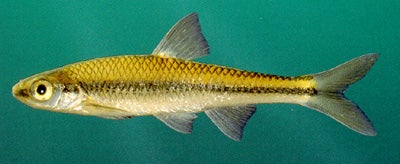WEED SHINER
SCIENTIFIC NAME: Notropis texanus
CHARACTERISTICS: The weed shiner is a small minnow with a fairly compressed body, a blunt, overhanging snout, and a terminal mouth. The black lateral band is well developed, extending from around the snout to the tail. The tail spot is small, either square or rounded, and narrower than the lateral band. Scales below the lateral band are slightly pigmented, and the last four rays of the anal fin are delicately outlined with melanophores. The back is olive yellow in life, with an overall body color of light brown to olive yellow. Notropis texanus is easily confused with the similar coastal shiner, N. petersoni, but the latter can be distinguished by its anal rays, all of which are outlined with melanophores. Breeding males have reddish orange of the back, above and below the tail spot, and on the back edges of the dorsal and caudal fins (Swift, 1970), while the back third of the anal fin is orange on specimens from Florida and lower Coastal Plain streams in Alabama.
ADULT SIZE: 1.4 to 2.2 in (35 to 55 mm)
DISTRIBUTION:The weed shiner is found in Gulf slope drainages from the Suwanee River west to the Nueces River in Texas and north throughout the Mississippi basin to Minnesota. This species commonly inhabits the Alabama Coastal Plain, and it occurs in a few localities above the Fall Line. Our collection of weed shiners from Second Creek in Lauderdale County is the first reported Tennessee drainage record of this species in Alabama. The relative location of this and another collection from Robinson Creek and further downstream in Tennessee (Etnier and Starnes, 1993) suggest that N. texanushas probably entered the Tennessee drainage via the Tennessee-Tombigbee Waterway.
HABITAT AND BIOLOGY: Notropis texanus is commonly found in small to large, low-gradient streams with sand substrates. Often associated, as its name implies, with emergent vegetation in shoal areas, it can be quite abundant when found. Gravid females have been collected from March through June, with most spawning in April and May. Bresnick and Heins (1977) report that most individuals live for more than two years, with few surviving beyond three years. This contrasts with the sand-dwelling cherryfinandlongnose shiners, Lythrurus roseipinnis and N. longirostris, which live for little more than one year. Stream drift made up of insects and plant material composes the diet.
ORIGINAL DESCRIPTION: The weed shiner was described by Girard in 1856.
ETYMOLOGY:
Notropis means keeled back.
Texanus means pertaining to Texas, the type locality.
The copyrighted information above is from Fishes of Alabama and the Mobile Basin.






